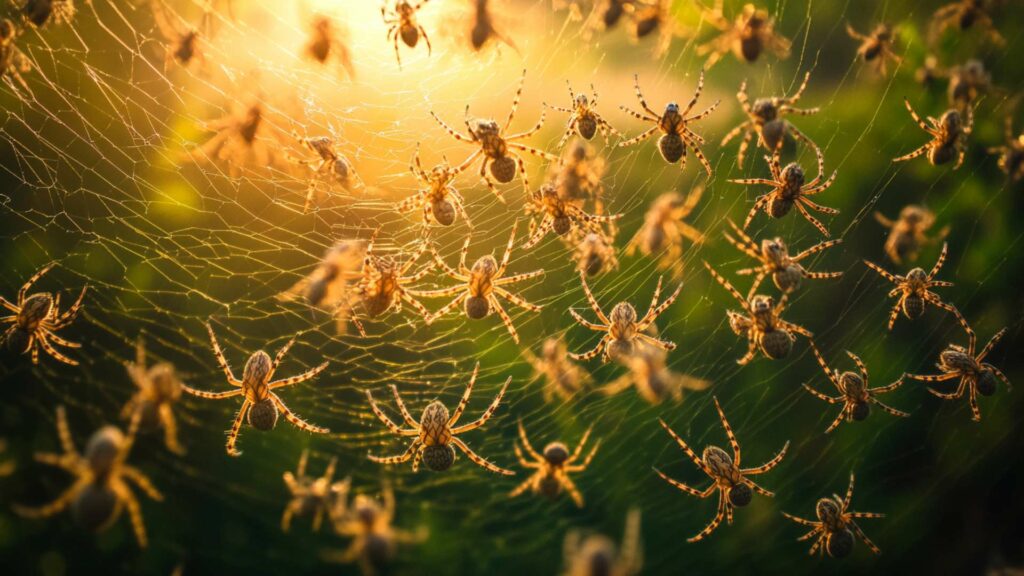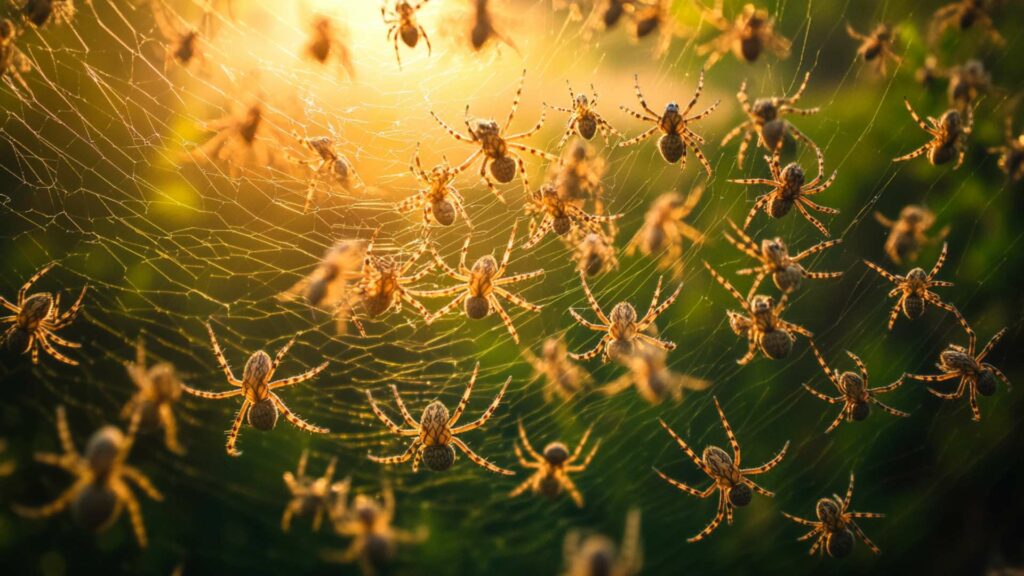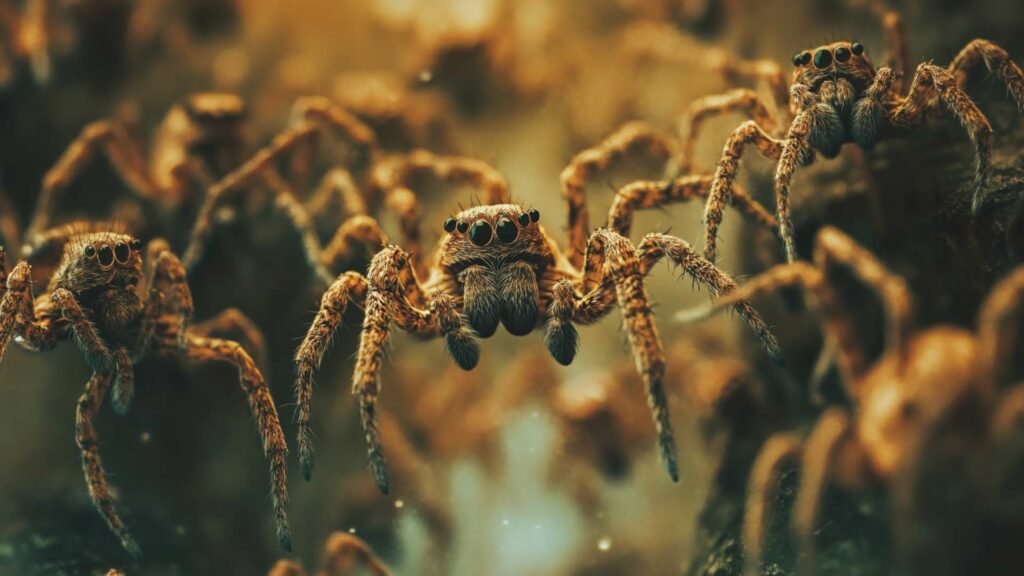Spiders: those eight-legged creatures that often send shivers down our spines, yet never fail to captivate our curiosity. Whether it’s their intricate webs, stealthy hunting techniques, or just their intimidating appearance, spiders have always held a special place in the realm of creepy crawlies. But it’s not just their ability to evoke fear that makes them fascinating; it’s also their complex anatomy and bewildering adaptations that pique our interest.
Fascination with Spiders
From a young age, we’re taught to regard spiders with caution and even mild disgust. However, for some of us, this initial aversion eventually transforms into a genuine fascination earliest spiders.
Many spiders possess an uncanny ability to weave intricate webs that seem like miniature works of art glistening in the morning dew. Others are skilled hunters capable of ambushing unsuspecting prey with lightning-fast precision.
But perhaps what truly captivates us is witnessing these arachnids in action: watching as they skillfully dismantle their web to consume trapped insects or observing how they meticulously tend to their egg sacs with maternal care. It’s these moments that remind us how diverse and astounding the world of spiders truly is.
Curiosity about Spider Anatomy
Beyond their captivating behaviors and astonishing webs lies a whole world hidden beneath the exoskeletal surface of these arachnids. Our curiosity about spider anatomy arises from questions such as “Do spiders have tongues?” or “How do they eat?” If you’ve ever observed a spider up close—perhaps while bravely rescuing it from your bathtub—you may have noticed its formidable fangs lurking within its mouth orifice.
These chelicerae (as they are scientifically called) act as the spider’s primary feeding appendages, equipped with venom-injecting fangs that allow them to immobilize their prey. But what about tongues?
Are spiders equipped with taste-sensitive hairs or any other organs that facilitate the sense of taste? This question has sparked debates and misconceptions among arachnid enthusiasts for years.
Spider Mouthparts: An Overview
Chelicerae: The Primary Feeding Appendages
When we think about how spiders eat and their eating habits, it’s essential to understand their unique mouthparts. At the forefront of a spider’s feeding apparatus are the chelicerae, which are like the jaws of these remarkable creatures.
Located on the front part of their heads, these appendages play a crucial role in capturing and securing prey. The chelicerae consist of two segments connected by a joint, giving them a scissor-like appearance.
At first glance, they may seem similar to jaws, but unlike other creatures with mouths full of teeth, spiders have evolved something entirely different. These adaptations enable them to inject venom into their victims instead of using mechanical chewing to break down solid food.
Fangs: Venom-injecting Structures

Behind those chelicerae lie another fascinating set of structures: the fangs. These specialized mouthparts act as venom-injecting needles that allow spiders to immobilize and eventually consume their prey. While commonly associated with venomous species like widow spiders or the iconic tarantulas, most spiders possess venomous fangs that serve varying purposes.
Interestingly enough, not all spider fangs are built alike. Depending on the spider species and its hunting methods, there can be differences in size and shape among fang structures.
For instance, jumping spiders typically have smaller fangs compared to web-building spiders that need more robust tools for capturing prey effectively. While these fangs might resemble the sharp edges of daggers ready to strike fear into our hearts, they play an essential role in a spider’s survival rather than being primarily used for defense or aggression towards humans or other animals.
In combination with the chelicerae, they facilitate feeding by injecting digestive enzymes into captured prey and allowing spiders to consume liquefied internal tissues efficiently. Overall, understanding the intricate structures of a spider’s mouthparts – the chelicerae and fangs – gives us insight into their feeding mechanisms and sheds light on their fascinating adaptations as skilled predators in the animal kingdom.
Clarifying misconceptions about spider tongues
When it comes to spiders, the notion of them having tongues is a common misconception that needs to be cleared up. You see, most spiders don’t have tongues or actually possess what we traditionally think of as tongues.
Instead, their feeding apparatus consists of specialized mouthparts known as chelicerae. These chelicerae serve as the primary feeding appendages for a spider’s stomach, and they differ significantly from the concept of a tongue.
Unlike humans and many other creatures that use their tongues for various purposes such as taste and manipulation of food, spiders utilize their chelicerae in a different manner. Their chelicerae are armed with fangs that play a crucial role in capturing prey.
These fangs are designed to pierce and inject venom into their victims, immobilizing them for consumption. So while spiders lack tongues in the traditional sense, they make up for it with their unique method of capturing and consuming prey.
Exploring alternate terminologies for spider mouthparts
Considering that spiders lack true tongues but have distinct mouthparts used for feeding purposes, it’s essential to explore alternative terminologies that accurately describe these structures. One commonly employed term is “cheliceral palps,” which refers to the sensory appendages located near the base of a spider’s chelicerae. Furthermore, some scientists prefer using words like “protrusible appendages” or “mouthparts” when referring to these structures instead of using the word tongue.
This terminology emphasizes the functional aspect rather than implying an anatomical similarity with traditional tongues. The use of precise language when discussing spider anatomy helps in dispelling misconceptions and ensuring accurate communication about these remarkable creatures.
Spinnerets: Silk-spinning organs located at the rear of the abdomen
Subtly Sublime Spinnerets: The Master Weavers of the Spider World In the intricate realm of spider anatomy, one can’t help but marvel at the spinnerets, those remarkable silk-spinning organs situated at the rear of a spider’s abdomen.
These tiny but mighty appendages are responsible for producing a variety of silken threads that play an indispensable role in a spider’s life. While it may seem covert, their significance is far from subtle.
Spinnerets are as diverse as spiders themselves, with variations in shape and size among different species. Typically, spiders possess six spinnerets arranged in pairs of eight legs, forming three sets near their posteriors.
These spinnerets consist of tiny spigots connected to silk glands within the spider’s body. Each spigot can extrude several strands of silk simultaneously, enabling spiders to spin webs, create intricate webs or perform other feats that astound even seasoned arachnologists.
Function and Versatility of Silk in a Spider’s Life

Silk: Nature’s Multipurpose Thread Silk isn’t just an ordinary substance; it is an extraordinary material that serves various purposes for our eight-legged friends. From constructing elaborate webs to creating egg sacs or even fashioning safety lines for locomotion, spiders ingeniously utilize silk to suit their diverse needs.
The primary function of silk is undoubtedly web-building – nature’s equivalent to engineering marvels. Spider webs come in a vast array of designs – from the classic orb-web spun by garden spiders to tangled sheets woven by funnel-web dwellers – each tailored to maximize its efficiency based on the spider’s habitat and prey capture strategy.
But silk goes beyond web-spinning; it also plays a crucial role in reproduction and protection. Female spiders encase their eggs in silk, creating secure sacs to safeguard the developing spiderlings.
Some spiders even construct nursery webs to house and care for their young until they are ready to venture out into the world. Additionally, certain spiders employ silk as a safety line while navigating through complex environments or as a lifeline during prolonged periods of food scarcity.
So, while spiders don’t possess tongues, they have mastered the art of silk production and manipulation, harnessing its multifaceted properties for an array of vital functions in their lives. It’s fascinating how something as delicate and intricate as silk can be woven into the very fabric of a spider’s survival strategy.
Taste Sensation in Spiders
Lack of traditional taste buds in spiders’ mouths
At first glance, it may seem odd that not all spiders have taste buds in their mouths like we do. However, the truth is that spiders have evolved with a unique way of experiencing taste. While they may not possess the traditional taste buds found in our tongues, they have adapted other sensory structures to fulfill this function.
Trichobothria: Sensory hairs that aid in detecting vibrations and air movements
One of the fascinating adaptations that spiders have developed is the presence of trichobothria – specialized sensory hairs located on their legs and bodies. These fine, elongated hairs serve as highly sensitive tactile receptors, allowing spiders to detect minute vibrations and air movements around them.
Though primarily associated with sensing their environment and detecting approaching prey or potential threats, these trichobothria also play a role in taste perception. When it comes to feeding, spiders use their trichobothria to assess the suitability of potential food sources by sensing chemical cues present in the environment.
These microscopic hairs are equipped with chemical detectors that can identify molecules released by prey items or other substances nearby. By brushing against objects or substances, they can sample them and determine if they are edible or potentially harmful.
So while spiders may not possess tongues as we do, their trichobothria act as an ingenious substitute for traditional taste buds. These sensitive sensory hairs enable them to navigate their world and make informed decisions about what they eat based on tactile cues and chemical signals rather than relying solely on oral sensations and bad taste, like we humans do.
It’s remarkable how nature has equipped these eight-legged creatures with such specialized adaptations for survival. As we delve deeper into understanding spider anatomy, it becomes clear that while they may be different from us or other arthropods when it comes to taste sensation, they have evolved intricate mechanisms to navigate their world and make informed decisions about what they consume.
Feeding Habits and Techniques of Spiders

Spiders are renowned for their predatory behavior, as the vast majority of them are carnivorous creatures. When it comes to obtaining their meals, spiders employ various hunting techniques that have evolved over millions of years.
One common approach is web-building, where certain spiders construct intricate silk structures with sticky strands to ensnare unsuspecting prey. These remarkable webs, resembling a delicate fishing net, serve as traps for insects that unwittingly stumble into them.
One well-known example is the orb-weaving spider, which creates circular-shaped webs suspended between trees or plants. However, not all spiders rely on webs for hunting; some prefer more active methods.
For instance, jumping spiders possess incredible agility and eyesight, allowing them to pounce on their prey with great precision. They use their strong legs to leap towards unsuspecting insects before swiftly immobilizing them with a venomous bite.
Usage of Venom to Immobilize Prey
Venom plays a crucial role in the feeding habits of most spider species and serves as a vital tool for subduing prey. While spiders lack traditional taste buds in their mouth orifice like humans do, they make up for it by injecting venom into their victims using specialized fangs located within their mouths.
These fangs come in different sizes depending on the spider species; larger fangs are often found in venomous spiders such as black widows or brown recluses. Once injected with venom from these potent arachnids, the prey quickly succumbs to paralysis or death due to the toxic effects of the venom.
It’s important to note that not all spiders have venomous fangs capable of harming humans or larger animals. Many harmless species like the wolf spider utilize venom primarily for immobilizing smaller insects and other arthropods that constitute their main diet.
The venom’s purpose in spider bites is not only to subdue the prey but also to initiate the digestion process. Once the venom immobilizes the prey, spiders use their fangs and specialized mouthparts to inject digestive enzymes that liquefy the internal tissues.
This liquid form of prey can then be sucked into the spider’s mouth and consumed or transported to other organs within their digestive tract for further processing. Spiders exhibit a diverse range of feeding habits and techniques, with hunting methods varying from web-building to active hunting.
Venom plays a crucial role in immobilizing their prey, allowing them to feed efficiently and effectively. Whether it’s through constructing intricate webs or using stealthy tactics, spiders have developed remarkable adaptations over time that enable them to thrive as skilled predators in the arthropod world.
Communication through Vibrations
Spider communication beyond oral language
While we often associate communication with spoken words or gestures, spiders have developed a fascinating alternative method: vibrations. Spiders possess an intricate ability to communicate through subtle movements in their webs, allowing them to convey important messages to other spiders without relying on traditional oral language. This form of communication has evolved as a vital means for spiders to navigate their complex social and environmental interactions.
Web vibrations as a means for mating, territorial disputes, and danger signals
Spider webs serve as both homes and hunting grounds, but they also double as intricate communication networks. For instance, male spiders often utilize web vibrations during courtship rituals to attract potential mates.
These delicate tremors travel along the strands of the web, carrying specific signals that advertise the male spider’s availability and desirability. Furthermore, web vibrations are crucial in resolving territorial disputes between spiders.
When one spider encroaches upon another spider’s eyes or turf, they engage in a display of aggressive behavior by vibrating their own web forcefully. This serves as a clear warning signal indicating ownership and discourages any further intrusion.
Notably, danger signals are also communicated through web vibrations. When confronted with potential threats such as predators or disturbances caused by human activity, spiders generate distinctive pulses or erratic movements within their webs to alert nearby individuals of imminent danger.
While we may associate verbal or visual cues with effective communication, spiders have mastered an incredible non-verbal system based on intricate web vibrations. Through this unique method, they can convey crucial information related to mating opportunities, territorial boundaries, and impending dangers within their environment.
Spider “Tongues” vs Other Arthropods’ Mouthparts
Comparison with other arthropods like insects or crustaceans
When discussing a spider’s jaws and “tongues,” it’s important to compare them with the mouthparts of other arthropods, such as insects and crustaceans. While spiders belong to the class Arachnida, which includes scorpions and ticks, insects fall under the class Insecta. Crustaceans, on the other hand, comprise creatures like crabs and lobsters.
The structure of mouthparts in these different arthropod groups varies significantly. Insects typically possess a complex set of mouthparts consisting of mandibles for biting and chewing, maxillae for holding food, and labium or tongue-like appendages for sucking stomach-manipulating liquids.
Crustaceans often have two pairs of mandibles along with specialized appendages called maxillipeds that aid in capturing and manipulating food. In contrast, spiders have evolved unique mouthpart structures that differ from both insects and crustaceans.
Spiders possess chelicerae instead of mandibles – these are the formidable appendages that allow spiders to capture prey by injecting venom through their fangs. Unlike insects that can manipulate food using their labium or tongue-like structures, spiders lack such specialized adaptations for processing solid food.
Differences in structure, function, and evolutionary adaptations
The structure of spider mouthparts reflects their predatory nature and dependence on liquid nutrition rather than solid consumption. The chelicerae in spiders are hollow structures armed with venom glands at their bases.
When hunting or defending themselves against threats, spiders use their fangs to pierce prey or enemies and inject venom into them – effectively turning the insides into a liquid form that is easier to consume. Additionally, while most species of web-building spiders rely on silk to immobilize prey and construct their intricate hunting webs, other spiders that actively hunt or ambush their prey have evolved different adaptations.
For example, wolf spiders possess shorter chelicerae and smaller fangs compared to cobweb weavers. This allows them to deliver venom more efficiently into their prey’s bodies while minimizing the risk of damaging or getting caught in their own webs.
These differences in structure and function of mouthparts among arthropods reflect the diverse evolutionary adaptations that have occurred over millions of years. While insects and crustaceans have developed mechanisms for feeding on solid food, spiders have carved a niche as formidable liquid-feeders, using their mouthparts to inject venom and consume liquefied prey from the inside out.
Fun Facts About Spider Mouthparts
Examples of Unique Adaptations Among Different Spider Species
When it comes to spider mouthparts, nature has crafted some truly remarkable adaptations. These intriguing features highlight the incredible diversity and specialized abilities of spiders across various species.
For instance, let’s take a look at the fascinating world of jumping spiders. These charismatic arachnids are known for their exceptional vision and agility when hunting prey.
Interestingly, they possess enlarged fangs that, at first glance, might make you think they have a tongue or some sort of specialized feeding organ. However, these larger fangs serve a different purpose – they are used as formidable weapons to immobilize and subdue their prey.
On the other hand, crab spiders showcase a unique adaptation related to their mouthparts. Unlike most spiders that capture prey by spinning webs or using other methods, crab spiders rely on camouflage to ambush their victims.
Their mouthparts are equipped with taste-sensitive hairs that allow them to detect vibrations when an unsuspecting insect lands nearby. This enables them to swiftly strike and manipulate their prey without needing an elaborate web structure.
Interesting Trivia Regarding Specialized Feeding Behaviors
Spiders exhibit a wide range of feeding behaviors that go beyond simply consuming their captured prey. For example, cobweb weavers often display intricate web-building patterns designed not only for trapping insects but also to provide protective shelters where they eat food in peace. Once caught in the web, these resourceful arachnids use specialized structures called pedipalps near their mouths to manipulate prey and deliver venom from venom glands.
It may surprise you to know that some spiders drink water as well! While many obtain moisture from the body fluids of captured insects or from dew on vegetation, certain species have developed interesting mechanisms for quenching their thirst.
The Australian water spider ingeniously constructs an underwater web, where it can reside for extended periods. This web functions as both a hunting ground and a dwelling, allowing the spider to capture prey and drink water at its leisure.
The world of spider mouthparts is filled with captivating adaptations and intriguing behaviors. From jumping spiders with their impressive fangs to crab spiders relying on camouflage, each species showcases unique features that highlight their specialized hunting strategies.
Whether it’s manipulating prey with pedipalps or constructing underwater webs for both sustenance and shelter, spiders continue to amaze us with their remarkable abilities. So next time you encounter a spider, take a moment to appreciate the wonders hiding within its mouthparts – nature’s ingenious creations at work!
Conclusion
The fascinating world of spiders and their intricate mouthparts has captivated us throughout this article. We have unraveled the mystery surrounding spider “tongues” and discovered that while spiders do not possess traditional tongues like humans or other animals, they have a diverse array of specialized mouthparts for various functions.
From their venom-injecting fangs to their silk-spinning spinnerets, these remarkable creatures have evolved unique adaptations to survive and thrive in their environments. Despite lacking taste buds in their mouths, spiders are not devoid of taste sensation.
They rely on sensory hairs called trichobothria to detect vibrations and air movements, aiding them in hunting and communication. Spiders’ feeding habits are predominantly predatory, with various hunting techniques employed by different species such as web-building, ambush tactics, or active hunting.
Their venom glands play a crucial role in immobilizing prey before ingestion. When it comes to communication, spiders go beyond oral language.
They utilize web vibrations as a means of signaling mating opportunities, territorial disputes, and danger warnings to other individuals of their species. This form of non-verbal communication showcases the complexity of spider behavior.
In exploring the comparison between spider mouthparts and those found in other arthropods like insects or crustaceans, we have observed significant differences in structure, function, and evolutionary adaptations. Spiders possess unique features that set them apart from their arthropod counterparts.
As we wrap up our investigation into whether or not spiders have tongues, we find solace in knowing that these incredible creatures are thriving with their specialized mouthparts despite not having traditional tongues. Their ability to manipulate prey’s body by using silk threads or swiftly capture it with venomous fangs highlights their adaptability as predators.
So next time you come across a spider spinning its intricate web or demonstrating its agility like a jumping spider pouncing on its prey – appreciate the wonders of nature’s engineering. While they may not have tongues in the conventional sense, spiders are truly remarkable creatures, constantly reminding us of the intricate diversity and beauty of the natural world.
Dominate spiders with D-Termination: Las Vegas’ top-choice Pest Control!

Anxious about spiders lurking in your Las Vegas property? D-Termination holds the key. Our adept team excels at eradicating spider infestations, reinstating serenity and calm to your surroundings. Bid adieu to spiders—opt for D-Termination’s potent pest control today!
Connect with us at 702-919-6310 or explore dtermination.com to reserve your spider control service and restore your space from these unwelcome intruders.
Frequently Asked Questions:
No, spiders do not have lips.
Spiders have taste receptors on their legs and pedipalps.
A spider’s mouth contains fangs and structures for feeding.
Yes, spiders have a simple brain called a cephalothorax.








